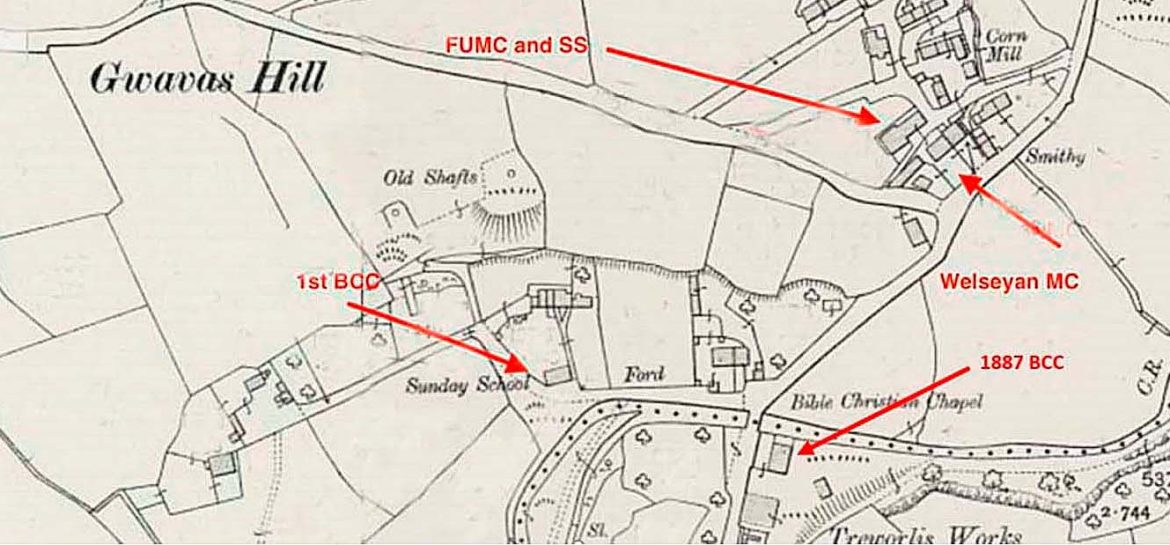Mapping Methodism – Lowertown / Lowertown Higher United Methodist Free Church (Tuckingmill / Anvower)
Categories Mapping Methodism0 Comments
Lowertown-by-Helston is a large hamlet in Sithney civil parish, bordering Wendron parish, in Cornwall, United Kingdom. The hamlet is one mile north of the centre of the town of Helston and is built around the River Cober. This profile of Lowertown / Lowertown Higher United Methodist Free Church has been compiled by Jo Lewis and Tony Mansell.
Earlier Chapel
1884: The U.M.F.C chapel at Lower town was not sold. (Cornishman – Thursday 09 October 1884) Whether this means that it was not included in the sale or it did not reach the reserve price, we do not know.
Became a Sunday school.
1970: Maps show this as Sunday school only.
1889 Chapel
1889: New Chapel for Lowertown. The Free Methodist at Lowertown have decided to erect new Chapel and transform their old one into a schoolroom. The ceremony of laying foundation stones took place Wednesday.… Mr. J. B. Nicholas, of is the contractor. (The Cornish Telegraph – Thursday 01 August 1889)
Carrying on past the turn to Gwavas Hill, take the next left to turn back towards Gwavas Hill. The back of the Mill (old site of wheel can be seen) is on the left before the corner. The United Methodist Chapel complex can be seen on the corner, the front accessed by a footpath.
1889: Build date.
Built as an United Methodist Free Church.
1907: The Methodist New Connexion, Bible Christians and United Methodist Free Churches amalgamated to become the United Methodist Church.
1907: Became a United Methodist Church.
1907: Appears on maps.
1932: The Wesleyan, Primitive Methodist and the United Methodist Church amalgamated to become the Methodist Church of Great Britain.
1932: Became Lowertown Methodist Church.
2000: The Old Sunday school East and West converted.
The complex became Lowertown Institute.
Lowertown Institute And Pavement With Gateway At The Front. Probably former nonconformist chapel including pavement and gate at the front built in 2 phases and later converted for use as a village institute. Circa mid-C19 and circa late C19. The original part is painted rubble with dressed granite quoins, jamb stones and lintels and brick arches; slurried scantle slate roof, half-hipped on the right and with a brick chimney over the right-hand end. The later part, left, is killas rubble with regular dressed granite quoins, sills, jamb stones and lintels; slurried scantle slate roof with gable ends. Cast-iron ogee gutters to both parts. Plan: 2 rectangular rooms, the original circa mid-Cl9 (probably chapel) right, and the circa late-C19 slightly deeper and taller part, left, projecting farther at the front. The left hand -room has galleried seating (sloping from floor level) at the left and a stage on the right with an organ bay right contrived by using part of the original chapel. Single storey. Overall, 4 window front comprising 2 symmetrical 2 window fronts each with a central doorway, the left-hand front built slightly forward from the original front, right. The original front has its original tall 18-pane hornless sashes and over the doorway, is a 9-pane fixed overlight to resemble the upper sashes. Ledged door. The openings are spanned by shallow brick arches. At the rear towards the right are two 12-pane sashes. The later front, left, has segmental granite monolithic arches over the openings. Ledged door and original tall 8-pane horned sashes. At the middle of the left-hand end are a pair of round-headed windows with marginal panes within a large round-headed opening. Interior : in the left-hand room there is the original plaster ceiling with a moulded cornice, ornate central rose and 4 smaller roses. The pitch-pine seating is also original. Possibly at the right-hand side (ritual east) there was originally a rostrum with a pulpit (now a simple stage). Raised wall at the front with square-on-plan granite monolithic posts, granite copings over a low wall and cast-iron gates with fleur-de-lys finials. Listing NGR: SW6589329238 Historic England)
2004: Chapel converted to dwelling “The Old Chapel”. (Planning documents)
